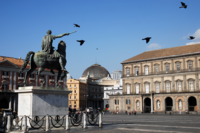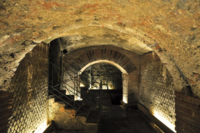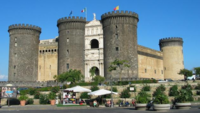

Often overshadowed by the iconic cities of Rome, Venice, Milan and Florence, Naples may not represent an obvious destination for a holiday. However, the coastal metropolis has a great deal to offer, and we’re about to highlight some of its most appealing features so you keen expats and travelers can discover it for yourself.
Start the day with a coffee at Caffe Mexico. The name suggest a rather peculiar place to make the most of Italian culture, but the espresso at this place is deemed by some as the best in Naples, offering a range of blends and cool 50’s-style packaging. The frothy iced coffee (frappe di caffé) is a particular favourite. What’s more, the cafe is a chain, so it can be found in several locations across the city.
There are several ways of getting around in Naples, but given that the road traffic is comparable to New York’s (busy) and taxis are sometimes unlicensed, perhaps the subway/metro is your best option. However, exploring on foot is surprisingly simple and the majority of the city’s most spectacular spots are within easy reach of each other.

To begin your sightseeing, head to Naples’ main square, Piazza del Plebiscito, to get a first impression of the city. The plaza was planned and built by King Murat of Naples for his brother-in-law, Emperor Napoleon, in the 19th century. The construction was then converted into the church of San Francisco de Paola, which is still there today. The church itself is reminiscent of the Pantheon in Rome, with a portico and a magnificent dome. Take in the façade from the front, with its columns and pillars, then peer inside at its majestic circular interior and two side chapels.
Also accessible from Piazza del Plebiscito is the Palazzo Reale. One of Naples’ main monuments, this sovereign spectacle should not be omitted from your itinerary. Dating back over 400 years, the palace is something to behold. The French are responsible for the neoclassical interior thanks to their rule in 19th century, the hanging garden and statues of Neapolitan kings came later on in that century. The imposing apartments house a collection of paintings, chandeliers, tapestries, frescoes and furniture from the 17th to 19th centuries. The Palace also includes within its grounds the Biblioteca Nazionale, containing masterpieces which date back as early as the fifth century.
Either as a supplement or an alternative, venture 35 metres below street level to explore the tunnels, aqueducts and chambers at Napoli Sotterranea . The tunnels date back to 4th century BC at the dawn of the Greek city of Neapolis, and were at one time incorporated into Naples’ water supply system. Take the 90 minute guided tour to learn all there is to know about this fascinating place.

For your afternoon meal in Naples you’re probably seeking the best place to enjoy traditional Italian cuisine, and therefore developing an appetite for pizza, pasta and fish caught from the Mediterranean. What better place to get a real taste of Italian cucina than the home of pizza and spaghetti!
The city includes a broad market for beautifully prepared food in a range of different styles, promising to satisfy the culinary desires of any traveller or expat. Just to point you in the right direction, Antica Osteria Pisano functions as both a lunch and dinner restaurant and serves as a kind of museum at the same time, opening the kitchen out to the restaurant so customers can admire how such dishes as pasta alla genovese are cooked up, for example.
Failing that, another option which might appeal to you is Cantina della Sapienza, where you’ll experience the closest thing to Neapolitan home-cooking you can find without breaking the bank. All menu combinations are under €10 and the restaurant offers friendly family service, decent vino locale (red) and delicious desserts. Finally, if a cheap but authentic pizza is what you fancy, try Da Michele because its portions are very generous and it is renowned for rapid service.
Why not adopt a ‘castle theme’ for the late afternoon’s activities; the city has two very grandiose ones and they are both easily worth a visit. The Castel Nuovo (Maschio Angioino) is the newest of the two castles (the nuovo in its name means ‘new’) but boasts a great deal of history. Hailed as a ‘critics’ choice’ of Neapolitan attractions by timeout.com, the fortress was built in 1249 by Charles of Anjou for the use of monarchs, then later became a centre of art and literature. Now, still a courtly castle, the site is also home to Naples’ Museo Civico, which includes ancient finds, a cemetery, 15-20th
century paintings, and views from the fortress towers.
If you don’t want to pay admission but can’t wait to hear more historical tales, don’t forget the Castel dell’Ovo . Its current appearance doesn’t bear the slightest resemblance to how the site looked under the Romans in the first century BC when it was part of general Lucullus’ estate. The castle has been occupied by the military for 1,000 years and its current look is due to work by the Aragonese in 16th century. Visitors should cross the bridge, pass through the portal and stroll over to where the gun emplacements used to stand, all the while painting an imaginary picture of historical military action.

If you still have time and energy, there’s even more to see. The priority in this case may well be the Duomo , Naples' ancient cathedral which dates back to the 4th century and houses an excavation of a Roman site. It also contains two charming chapels and the St. Gennaro Treasury museum. Alternatively, those who would prefer to see something less touristy and conventional should perhaps try the Carthusian monastery, Certosa-Museo di San Martino , located at the top of a hill and housing the Museum of City History; or maybe if you have kids or just love wildlife, head out to Villa Comunale , a pleasant park near the shore, to admire the aquarium or see an exhibition at La Casina Pompeiana .
Whether you’re looking for a candlelit dinner with your partner or to take your family out for a fancy meal, you’re going to want to unwind after a full day of sightseeing with something decent and memorable to eat. With this in mind, there are a few distinct options according to different priorities.
For a romantic dinner that you’ll cherish as a couple, book a table at Al Faretto/Al Faro to enjoy a well-prepared dish of seafood or pizza with a quality bottle of wine in the tranquility of the secluded restaurant looking out from its terrace.
For a hearty traditional meal, try Antica Trattoria da Carmine which is located near the ancient church of San Lorenzo Maggiore and specialises in pasta, patate e provola as well as beef fillet. It also leaves you with some money remaining in your pocket.
For interesting recipes, great sea food, a pleasant setting and good quality service, eat at Poseidone. One dish combines fresh mussels with aubergine, and they offer a baked white chocolate dessert which you’d be silly not to try.
On a short trip abroad, every traveller wants to top off the break with an evening activity that entertains and remains in the brain. A fine choice would be the Tam cabaret which comes to Naples every weekend and is a hit with both locals and tourists. Timeout.com’s review of it labels it “cosy, colourful and lots of fun”, and it includes the option for dinner and bar service.
The youngsters among you may prefer the Galleria Toledo theatre which puts on shows involving alternative Italian and international bands, or films during the cooler months.
The amount of possibilities in Naples are too vast to include in an article which suggests just enough activities for one or two days, so we’re aware that some things on the list may not tickle your fancy. However, it is upon solid recommendations that these suggestions have come about, so hopefully this itinerary fulfills all your wants and expectations associated with a trip to this wonderful city.